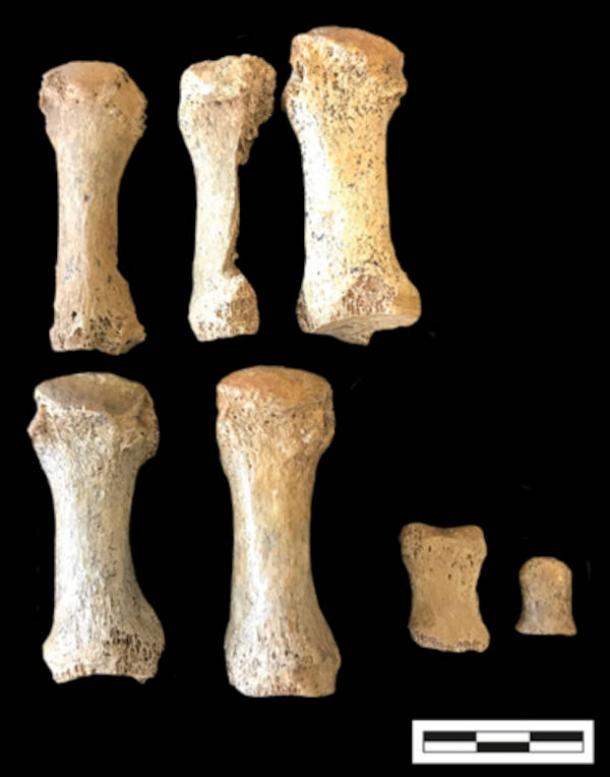In the 1970s a skeleton was unearthed at an ancient Roman cemetery in Belgium that was thought to have belonged to a woman who lived between the years 69 and 210, during the Gallo-Roman era. This judgment was made even though the body was buried in a fetal position, which was not the Roman custom, because of the presence of a Roman bone pin found near the skull.
But when radiocarbon dating tests were performed on the skeleton in 2019, the results were truly stunning. They showed that the grave contained a mixture of bones from different eras, meaning the skeleton was some kind of composite arranged to look like a single person.
In a new analysis just completed by an international team of archaeologists and genetics, it has been determined that the “individual” buried in the cemetery in ancient Gaul was constructed from the bones of five different people from three different periods who lived 2,500 years apart. The earliest of the bones (the skull) did indeed come from Belgium’s Roman period. But the other bones belonged to people who lived in the Middle and Late Neolithic periods.

A) left and right scapulae (posterior aspects); B) left and right os coxae (antero-medial aspects). (Veselka et al./Antiquity Publications Ltd)
Assembled Like a Puzzle: The Pommerœul Enigma
The skeletal remains were found during excavations that took place in the 1970s, at a Roman cemetery near the village of Pommerœul in the province of Hainaut near Begium’s border with France.
At the time this was considered a major find, as the remains of 76 cremated bodies were recovered along with what everyone believed was one intact skeleton. The cemetery was located close to the ruins of a fairly large Gallo-Roman settlement that had been occupied during the second and third centuries, meaning the burial ground cemetery was almost certainly connected to this Roman outpost.
When genetic tests were carried out in 2019 on all the remains retrieved from this ancient graveyard, they showed that all the cremated bodies had come from the Roman era. But in the case of the one anomalous skeleton, the results showed that only the skull could be dated to that time period. The rest of the bones were much older, which was peculiar because the bones had clearly all been arranged to make it seem as if they came from a single individual.
No one knew exactly what to make of all this, and even now the story of how and why this composite skeleton was constructed remains unknown.
In the most recent study, a team of scientists led by Professor Barbara Veselka, head of the osteoarchaeology laboratory at Vrije University in Brussels, took a fresh look at the skeletal remains, to see if they could discover at least some of bones’ secrets. This new study was carried out under the auspices of the CRUMBEL Project, an initiative launched to support the analysis of cremated bones found in Belgium that date from the Neolithic period through the Early Medieval era (from approximately 3000 BC to 700 AD).
“A closer examination revealed that the skeleton among the cremated remains was very special,” Professor Veselka said in an interview with the Brussels Times. “The skeleton was assembled like a puzzle, and this did not occur during or after the excavations.”
Soo can the experts fathom why was this done and by whom?

Five adult right first metatarsals and two first proximal foot phalanges from two different non-adults, all found in grave 26. (Veselka et al./Antiquity Publications Ltd)
Why Did the Romans Do It? Let the Speculation Begin
In an article about their study published in the journal Antiquity, the scientists offer two possible explanations for this incredible find.
The first is that gravediggers burying the cremated remains of deceased Romans stumbled upon the more ancient collection of bones by accident, and then took action to repair whatever damage they thought they’d done by “Romanizing” the remains.
“Either there was originally no cranium and the Roman community that discovered the burial added one to complete the ‘individual’, or they replaced the existing Neolithic-date cranium with a Roman-period one,” they study authors wrote in their Antiquity article. “In either case, the pin seems to have been added, perhaps as a grave good, at this time.”
The other explanation is the most fascinating, and that would be that the skeleton “was assembled during the Gallo-Roman period, combining locally sourced Neolithic bones with a Roman-period cranium,” creating what was essentially a skeletal version of Frankenstein’s monster.
“If so,” the researchers wrote, “to our knowledge, this would be the first Roman grave in which a new ‘individual’ was assembled from prehistoric and Roman bones.”
While the researchers don’t rule out the second scenario, they consider the first the most likely. This is because the skeleton was arranged in a fetal position, as was common in Neolithic burials, and not in the stretched-out, face-up position preferred by the Romans.
What the researchers suspect is that the composite burial was created during the Neolithic period, and that when the Romans accidentally dug it up they contributed a contemporary skull to the older burial.
“Disturbance of the burial may have necessitated reparations through the completion or construction of an individual with agency in the afterlife,” the study authors speculated, trying to understand the metaphysical reasons for this extraordinary act.
In the end, there is no way to know for sure what happened. Without written records, or further evidence of composite burials, this strange set of skeletal remains will likely always be classified as a true anomaly.